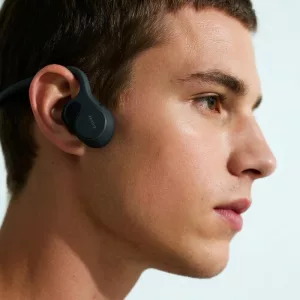Bone conduction headphones are often seen as a safer alternative, but that perception can be misleading.
Although they don't go inside your ears, bone conduction headphones can still pose a risk to your hearing—especially when used at high volumes over extended periods. The key factor isn’t the technology itself, but how loud and how long you listen.
It might seem like a smart choice: headphones that leave your ears open, letting you stay aware of your surroundings while catching up on your favorite podcast. But their placement on your cheekbones doesn't automatically make them harmless. Like any audio device, safe use depends on volume control and listening habits.
Who should not use bone conduction headphones?
Bone conduction headphones aren't the best fit for everyone. While they offer unique advantages, they also come with certain drawbacks that might make them less ideal for some users.
For those who crave deep bass or need complete noise isolation, bone conduction headphones may fall short. They're also not the best choice for intense workouts or people with specific head shapes.

Let’s dive into who might want to reconsider bone conduction headphones. If you're someone who enjoys powerful, rumbling bass, these headphones probably won't deliver. Their open design, which relies on vibrations through your cheekbones, can't replicate the low-frequency depth that traditional headphones provide. I found this out myself when I switched to bone conduction for my morning runs—the sound felt noticeably thinner compared to my usual headphones.
Then there’s head shape. Bone conduction headphones work by transmitting sound through your cheekbones, so a poor fit means poor sound quality. I have a friend with a smaller head who finds herself constantly adjusting her headphones during high-impact exercises, especially when jumping or sprinting. It’s a real hassle, and it can totally disrupt the workout.
Another factor to consider is how sensitive you are to surrounding noise. Since bone conduction headphones don’t block out external sounds, they let everything in—whether it's a dog barking or traffic noises. This might be fine if you’re looking to stay aware of your environment, but for some, it’s just plain distracting.
Here’s a breakdown to help understand who should avoid them:
| Group | Reason |
|---|---|
| Bass lovers | Weak low-frequency performance |
| Noise-sensitive users | Can't isolate external sounds |
| High-intensity athletes | May not stay in place during fast movement |
| People with certain head shapes | Inconsistent fit or audio quality |
So, while bone conduction headphones have a lot of upsides, they’re clearly not one-size-fits-all.
Can bone conduction damage your ears?
Some think that just because the sound doesn't go through your ear canal, there’s no risk. That’s a myth.
Any headphone—bone conduction or not—can damage your hearing if the volume is too loud for too long.

Let’s clear up a common misconception: bone conduction doesn’t automatically make listening safer. I've heard people say, “They don’t go in your ears, so they must be harmless.” That’s not the whole story.
What really matters is volume and duration. A 2021 study revealed that 1.7% of the global population suffers from hearing loss due to noise exposure. The research also found that people who frequently use headphones in noisy environments are 4.5 times more likely to develop hearing problems. Whether you're using earbuds, over-ear headphones, or bone conduction, the real danger comes from blasting the volume too high.
Here’s the deal with bone conduction: it’s different from traditional headphones, but it’s still not without risks. These devices sit just outside your ears, delivering sound through vibrations in your bones. Since they don’t block the ear canal, they allow you to hear your surroundings—great for staying aware of traffic or conversations. However, when you’re in a noisy place, like a busy street or crowded train, you might be tempted to turn up the volume. That’s when the risk of hearing damage increases.
On the bright side, bone conduction headphones can actually help you keep the volume at safer levels. Because they bypass the ear canal and send sound directly to the inner ear, you can still hear your music clearly at moderate volumes, even in noisy environments. Plus, since they don’t seal off your ears, you’re more aware of outside sounds, which can help reduce the temptation to blast your music too loud.
Let’s break it down simply:
| Factor | Traditional Headphones | Bone Conduction |
|---|---|---|
| Ear canal usage | Yes | No |
| External sound blocked | Mostly | No |
| Need to raise volume in noise | Often | Less often |
| Risk of hearing damage | High if misused | Still high if misused |
Bottom line? It’s not about the type of headphone—it’s how you use them.
Conclusion
Bone conduction headphones are not risk-free, but with smart use, they offer a safer way to stay connected and aware without sacrificing your hearing.





